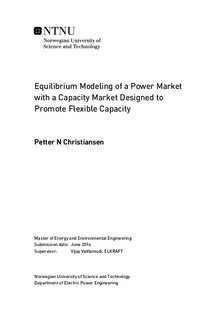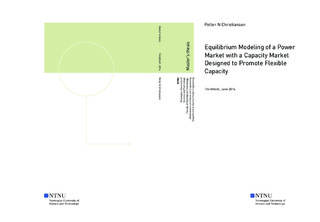| dc.description.abstract | Higher penetration of Renewable Energy Sources (RES) in the European power system has led to reduction in operating hours and revenues for conventional generators with load following capabilities. Therefore it has been argued there is a need for capacity remuneration mechanisms (CRM) to promote these generators. This thesis looks into a suggestion of a capacity market, where flexible generation technologies are paid higher prices for available capacity than less flexible generation technologies. Flexibility is here used as a term describing high ramping rates and short start-up and shut-down time for generators.
The main objective of this thesis is to develop an equilibrium model of a power market including a two-priced capacity market, with one flexible capacity price paid only to available flexible capacity, and one secondary capacity price paid to all available capacity. The model will be formulated as a mixed complementary problem (MCP). For comparison, a traditional single-priced capacity market and an energy-only market will be modeled. The three market designs will be tested on a one-node system representing the German power market in 2030, with high levels of intermittent RES.
In the model developed, each electricity producer represents a generation technology. Four producers, under the assumption of perfect competition, are included in the model; Nuclear, Coal, CCGT and OCGT generators. A MCP model has the ability of containing multiple objection functions. Each power producer optimize its profit individually, and the costs for the demand side and system operator are minimized. The two-priced capacity market categorize the producers in two groups:
Flexible Producers: CCGT and OCGT
Non-flexible Producers: Nuclear and Coal
The results and discussion of a base case will compare the installed capacity, load shedding, energy-based and capacity-based prices and revenues of producers of the three market designs. The goal is to see if the two-priced capacity model can promote flexible capacity. Sensitivity analyses are performed on a number of cases, to show the strength of the results from the base case.
In this thesis, the first known model of a two-priced capacity market is successfully constructed. It shows that this model indeed has the ability to give an advantage in the power market to flexible electricity producer over less flexible producers. Comparing the two-priced capacity market with a traditional single-priced capacity market, it can be concluded that both designs result in equal total capacity installed reaching the wanted capacity reserve margin. However, the two-priced capacity market results in more flexible capacity installed. This work is a foundation of a model of the two-priced capacity market, and future work should expand the model to further investigate the benefits of the two-priced capacity market over traditional capacity market designs. This further work can provide information to the research field and to policymakers to help constructing a power market design fit for a future with high shares of intermittent RES. | |

